Thermal Performance Analysis on the Seasonal Heat Storage by Deep Borehole Heat Exchanger with the Extended Finite Line Source Model
Abstract
:1. Introduction
2. Heat Transfer Modeling for the Deep BTES System
2.1. Model Assumptions
2.2. Unsteady Heat Transfer Analysis outside the Deep Borehole
2.2.1. Green Function for Transient Thermal Response in the Rock
2.2.2. Finite Line Heat Source Model
2.2.3. Extended Finite Line Heat Source Model
2.2.4. Superposition Principle of Step Heat Impulses
2.3. Quasi-Steady State Heat Transfer inside the Deep Borehole
2.3.1. Thermal Balance Analysis and Thermal Resistance for the One-Dimensional Heat Transfer
2.3.2. Heat Storage Model during Charging
- (1)
- Outlet temperature of the circulating water:
- (2)
- Heat flux density distribution along borehole depth:
2.3.3. Heat Extraction Model during Discharging
3. Heat Storage Performance Indicators
4. Evaluation
4.1. Project Overview
4.2. Thermal Performance Analysis of Deep BTES during Heat Storage
4.2.1. Thermal Performance of Deep BTES Charged by Low Temperature Water
4.2.2. Thermal Performance of Deep BTES Charged by High Temperature Water
4.3. Thermal Performance of Deep BTES during the Discharging Stage after Heat Storage
4.4. Analysis on the Heat Storage Efficiency by Deep BTES
5. Discussion
5.1. Comment on the EFLS Model for Deep BTES
5.2. Discussion on Heat Storage by Deep BTES and Future Prospect
6. Conclusions
- (1)
- EFLS model proves robust and efficient enough for credible simulation of actual deep BTES system. In addition, the model allows flexible switch between multiple operation conditions (operating or intermittence, heat extraction or heat storage, constant or variable flow rate and inlet temperature), which greatly facilitates the simulation of complicated heat transfer in deep BTES system.
- (2)
- Deep BTES transits rapidly from the initial unsteady heat transfer to the steady stage. The entire operation can be divided into three typical phases: initial unsteady phase, transition phase and the terminal steady phase. In the initial start-up phase, outlet temperature and the heat storage or heat extraction rate displays a rapid decrease. Shortly after the transition, the deep BTES enters the steady heat transfer state. Afterwards, it began operating steadily with only negligible fluctuation in the thermal performance parameters.
- (3)
- During the low temperature heat storage, only upper section of the borehole wall acts as effective heat storage section while heat extraction occurs along the bottom part. Circulating water in the inner pipe reaches its maximum temperature at the bottom of the borehole and returning upward to the surface along the annulus. Given the relatively uniform distribution of rock thermal parameters along depth, heat front spreads along the radial direction at almost the same rate, resulting in a thermal affected zone of the same size vertically. V-shaped isotherm profile in the rock could be clearly observed during the charging. In addition, greater temperature decrease occurs at the bottom of the borehole than the top section due to the linear increase of heat flux density along depth.
- (4)
- Low temperature heat storage displays distinctive characteristics from high temperature heat storage. When low temperature heat storage is carried out by transferring heat from the deeper rock to the shallower layers, enhancement of heat extraction potential during the heating season is not significant. This could be justified from two aspects. On one hand, the heat extracted from deep rock to the surface will diffuse away quickly. On the other hand, it is difficult for deep rock to recover its original undisturbed temperature. In general, it is advisable to start heat extraction immediately after low temperature heat storage.
- (5)
- High temperature heat storage by DBHE can only enhance the heat extraction potential for 30 to 40 days in the initial stage of heating. Maximum thermal performance enhancement up to 11.27 times was achieved due to seasonal heat storage. Throughout the discharging, average heat extraction rate was 1467.7 kW with an enhancement ratio of 4.36 relative to the stable state. Moreover, to properly eliminate influence of the inconsistent heat storage or heat extraction duration, evaluation of heat storage efficiency could be performed based on average heat exchange rate. Under this condition, thermal performance of the deep BTES system would be assessed more reasonably, where the heat storage efficiency was 2.86.
Author Contributions
Funding
Data Availability Statement
Acknowledgments
Conflicts of Interest
Nomenclature
| Nomenclature | |
| BHE | Borehole heat exchanger |
| DBHE | Deep borehole heat exchanger |
| GSHP | Borehole thermal energy storage |
| BTES | Borehole thermal energy storage |
| FLS | Finite line source model |
| EFLS | Extended finite line source model |
| OGS | Open GeoSys |
| Notations | |
| Depth of borehole | |
| Operation time of deep borehole heat exchanger | |
| Thermal diffusion coefficient | |
| Radius of borehole | |
| Drilling depth of borehole | |
| Initial rock temperature distribution | |
| Rock temperature field | |
| Circulating flow rate | |
| Inlet temperature of circulating water | |
| Outlet temperature of circulating water | |
| Flow temperature distribution along annulus of deep borehole heat exchanger | |
| Flow temperature distribution along inner pipe of deep borehole heat exchanger | |
| Total heat storage amount during charging of deep borehole heat exchanger | |
| Total heat extraction output during discharging of deep borehole heat exchanger |
References
- Thomas, K.; Renzo, B.; Walter, E. System performance of a deep borehole heat exchanger. Geothermics 2002, 31, 687–708. [Google Scholar]
- Rybach, L.; Hopkirk, R. Shallow and deep borehole heat exchangers-achievements and prospects. In Proceedings of the 1st World Geothermal Congress (WGC1995), Florence, Italy, 18–31 May 1995; pp. 2133–2139. [Google Scholar]
- Deng, J.W.; Wei, Q.P.; Liang, M.; He, S.; Zhang, H. Field test on energy performance of medium-depth geothermal heat pump systems (MD-GHPs). Energy Build. 2019, 184, 289–299. [Google Scholar] [CrossRef]
- Bu, X.B.; Ran, Y.M.; Zhang, D.D. Experimental and simulation studies of geothermal single well for building heating. Renew. Energy 2019, 143, 1902–1909. [Google Scholar] [CrossRef]
- Cai, W.L.; Wang, F.H.; Chen, S.; Shao, H.B. Analysis of heat extraction performance and long-term sustainability for multiple deep borehole heat exchanger array: A project-based study. Appl. Energy 2021, 289, 116590. [Google Scholar] [CrossRef]
- Huang, Y.; Zhang, Y.; Xie, Y.; Zhang, Y.; Ma, J. Field test and numerical investigation on deep coaxial borehole heat exchanger based on distributed optical fiber temperature sensor. Energy 2020, 210, 118643. [Google Scholar] [CrossRef]
- Wang, Z.H.; Wang, F.H.; Liu, J.; Ma, Z.J.; Han, E.S.; Song, M.J. Field test and numerical investigation on the heat transfer characteristics and optimal design of the heat exchangers of a deep borehole ground source heat pump system. Energy Convers. Manag. 2017, 153, 603–615. [Google Scholar] [CrossRef]
- Schulte, D. Simulation and Optimization of Medium Deep Borehole Thermal Energy Storage Systems. Ph.D. Thesis, Technische Universitat Darmstadt, Darmstadt, Germany, 2016. [Google Scholar]
- Luo, Y.Q.; Guo, H.S.; Meggers, F.; Zhang, L. Deep coaxial borehole heat exchanger: Analytical modeling and thermal analysis. Energy 2019, 185, 1298–1313. [Google Scholar] [CrossRef]
- Ma, L.; Zhao, Y.Z.; Yin, H.M.; Zhao, J.; Li, W.J.; Wang, H.Y. A coupled heat transfer model of medium-depth downhole coaxial heat exchanger based on the piecewise analytical solution. Energy Convers. Manag. 2019, 204, 112038. [Google Scholar] [CrossRef]
- Liu, J.; Wang, F.H.; Cai, W.L.; Wang, Z.H.; Wei, Q.P.; Deng, J.W. Numerical study on the effects of design parameters on the heat transfer performance of coaxial deep borehole heat exchanger. Int. J. Energy Res. 2019, 43, 6337–6352. [Google Scholar] [CrossRef]
- Zhao, Y.Z.; Pang, Z.H.; Huang, Y.H.; Ma, Z.B. An efficient hybrid model for thermal analysis of deep borehole heat exchangers. Geotherm. Energy 2020, 8, 18. [Google Scholar] [CrossRef]
- Jordi, J.M. Large-Scale Underground Thermal Energy Storage Using Industrial Waste Heat to Supply District Heating. Bachelor’s Thesis, Universitat de Lleida, Lleida, Spain, 2014. [Google Scholar]
- Emil, N.; Patrik, R. Performance evaluation of an industrial borehole thermal energy storage (BTES) project-Experiences from the first seven years of operation. Renew. Energy. 2019, 143, 1022–1034. [Google Scholar]
- Xu, L.Y.; Torrens, I.; Guo, F.; Yang, X.D.; Hensen, J.L.M. Application of large underground seasonal thermal energy storage in district heating system: A model-based energy performance assessment of a pilot system in Chifeng, China. Appl. Therm. Eng. 2018, 137, 319–328. [Google Scholar] [CrossRef]
- Xiong, R.; Li, H.L.; Zhou, X. Advanced energy storage technologies and their applications. Energies 2017, 10, 1366. [Google Scholar] [CrossRef] [Green Version]
- Diersch, H.J.G.; Bauer, D. Analysis, modeling and simulation of underground thermal energy storage (UTES) systems. In Woodhead Publishing Series in Energy, Advances in Thermal Energy Storage Systems; Woodhead Publishing: Sawston, UK, 2015; pp. 149–183. [Google Scholar]
- Michael, L.; Paulo, C.T.V. Seasonal thermal energy storage: A critical review on BTES systems, modeling, and system design for higher system efficiency. Energies 2017, 10, 743–766. [Google Scholar]
- Bastian, W.; Wolfram, R.; Schulte, D.; Kristian, B.; Ingo, S. Characteristics of medium deep borehole thermal energy storage. Int. J. Energy Res. 2016, 40, 1855–1868. [Google Scholar]
- Kristian, B.; Wolfram, R.; Bastian, W.; Schulte, D.; Sebastian, H.; Ingo, S. Seasonal high temperature heat storage with medium deep borehole heat exchangers. Energy Procedia 2015, 76, 351–360. [Google Scholar]
- Farzin, M.R.; Alan, S.F. Solar community heating and cooling system with borehole thermal energy storage—Review of systems. Renew. Sustain. Energy Rev. 2016, 60, 1550–1561. [Google Scholar]
- Fang, L.; Diao, N.R.; Shao, Z.K.; Zhu, K.; Fang, Z.H. A computationally efficient numerical model for heat transfer simulation of deep borehole heat exchangers. Energy Build. 2018, 167, 79–88. [Google Scholar] [CrossRef]
- Georgios, F.; Soteris, K. Ground heat exchangers-A review of systems, models and applications. Renew. Energy 2007, 32, 2461–2478. [Google Scholar]
- Li, M.; Zhu, K.; Fang, Z.H. Analytical methods for analysis of vertical ground heat exchangers (GHEs). In Advances in Ground Heat Pump Systems; Simon, R., Ed.; Woodhead Publishing: Sawston, UK; Elsevier Inc.: Amsterdam, The Netherlands, 2016. [Google Scholar]
- Bauer, D.; Heidemann, W.; Diersch, H.J.G. Transient 3D analysis of borehole heat exchanger modeling. Geothermics 2011, 40, 250–260. [Google Scholar] [CrossRef]
- Zhao, Y.; Qin, X.; Shi, X. Heat transfer modeling on high-temperature charging and discharging of deep borehole heat exchanger with transient strong heat flux. Sustainability 2022, 14, 9702. [Google Scholar] [CrossRef]
- Luo, Y.Q.; Yu, J.H.; Yan, T.; Zhang, L.; Liu, X. Improved analytical modeling and system performance evaluation of deep coaxial borehole heat exchanger with segmented finite cylinder source method. Energy Build. 2020, 212, 109829. [Google Scholar] [CrossRef]
- Luo, Y.Q.; Cheng, N.; Xu, G.Z. Analytical modeling and thermal analysis of deep coaxial borehole heat exchanger with stratified-seepage-segmented finite line source method (S3-FLS). Energy Build. 2021, 257, 111795. [Google Scholar] [CrossRef]
- Hellstrom, G. Ground Heat Storage Thermal Analysis of Duct Storage Systems. Ph.D. Thesis, University of Lund, Lund, Sweden, 1991. [Google Scholar]
- Eskilson, P. Thermal Analysis of Heat Extraction Boreholes. Ph.D. Thesis, University of Lund, Lund, Sweden, 1987. [Google Scholar]
- Carslaw, H.S.; Jaeger, J.C. Conduction of Heat in Solids; Claremore Press: Oxford, UK, 1947; pp. 257–265. [Google Scholar]
- Zeng, H.; Diao, N.; Fang, Z.H. A finite line-source model for boreholes in geothermal heat exchangers. Heat Transfer Asian Res. 2002, 31, 558–567. [Google Scholar] [CrossRef]
- Jaime, A.R.; Philipp, B.; Peter, B. Influence of spatially variable ground heat flux on closed-loop geothermal systems: Line source model with nonhomogeneous Cauchy-type top boundary conditions. Appl. Energy 2016, 180, 572–585. [Google Scholar]
- Jaime, A.R.; Philipp, B.; Peter, B. A finite line source model with Cauchy-type top boundary conditions for simulating near surface effects on borehole heat exchangers. Energy 2016, 98, 50–63. [Google Scholar]
- Tatyana, V.B.; Álvaro, M.; Esther, F.; Juan, L.G.S.; José, M.I.; Jezabel, P.; Pedro, J.F.d.C.; Javier, F.U. Finite line-source model for borehole heat exchangers: Effect of vertical temperature variations. Geothermics 2009, 38, 263–270. [Google Scholar]
- Li, M.; Lai, A.C.K. Heat-source solutions to heat conduction in anisotropic media with application to pile and borehole ground heat exchangers. Appl. Energy 2012, 96, 451–458. [Google Scholar] [CrossRef]
- Zhang, L.; Zhang, Q.; Huang, G. A transient quasi-3D entire time scale line source model for the fluid and ground temperature prediction of vertical ground heat exchangers (GHEs). Appl. Energy 2016, 170, 65–75. [Google Scholar] [CrossRef]
- Massimo, C. Fluid and borehole wall temperature profiles in vertical geothermal boreholes with multiple U-tubes. Renew. Energy 2016, 96, 137–147. [Google Scholar]
- Bauer, D.; Heidemann, W.; Müller-Steinhagen, H.; Diersch, H.J.G. Thermal resistance and capacity models for borehole heat exchangers. Int. J. Energy Res. 2011, 35, 312–320. [Google Scholar] [CrossRef]
- Michele, D.C.; Massimo, T.; Angelo, Z.; Roberto, Z. A computational capacity resistance model (CaRM) for vertical ground-coupled heat exchangers. Renew. Energy 2010, 35, 1537–1550. [Google Scholar]
- Kolditz, O.; Bauer, S.; Bilke, L. OpenGeoSys: An open-source initiative for numerical simulation of thermo-hydro-mechanical/chemical (THM/C) processes in porous media. Environ. Earth Sci. 2012, 67, 589–599. [Google Scholar] [CrossRef]
- Georg, K.; Norihiro, W. OpenGeoSys-Gem: A numerical tool for calculating geochemical and porosity changes in saturated and partially saturated media. Phys. Chem. Earth 2014, 70, 138–149. [Google Scholar]
- Bastian, J.G.; Dedong, L.; Sebastian, B. The coupled simulator ECLIPSE—OpenGeoSys for the simulation of CO2 storage in saline formations. Energy Procedia 2011, 4, 3794–3800. [Google Scholar]
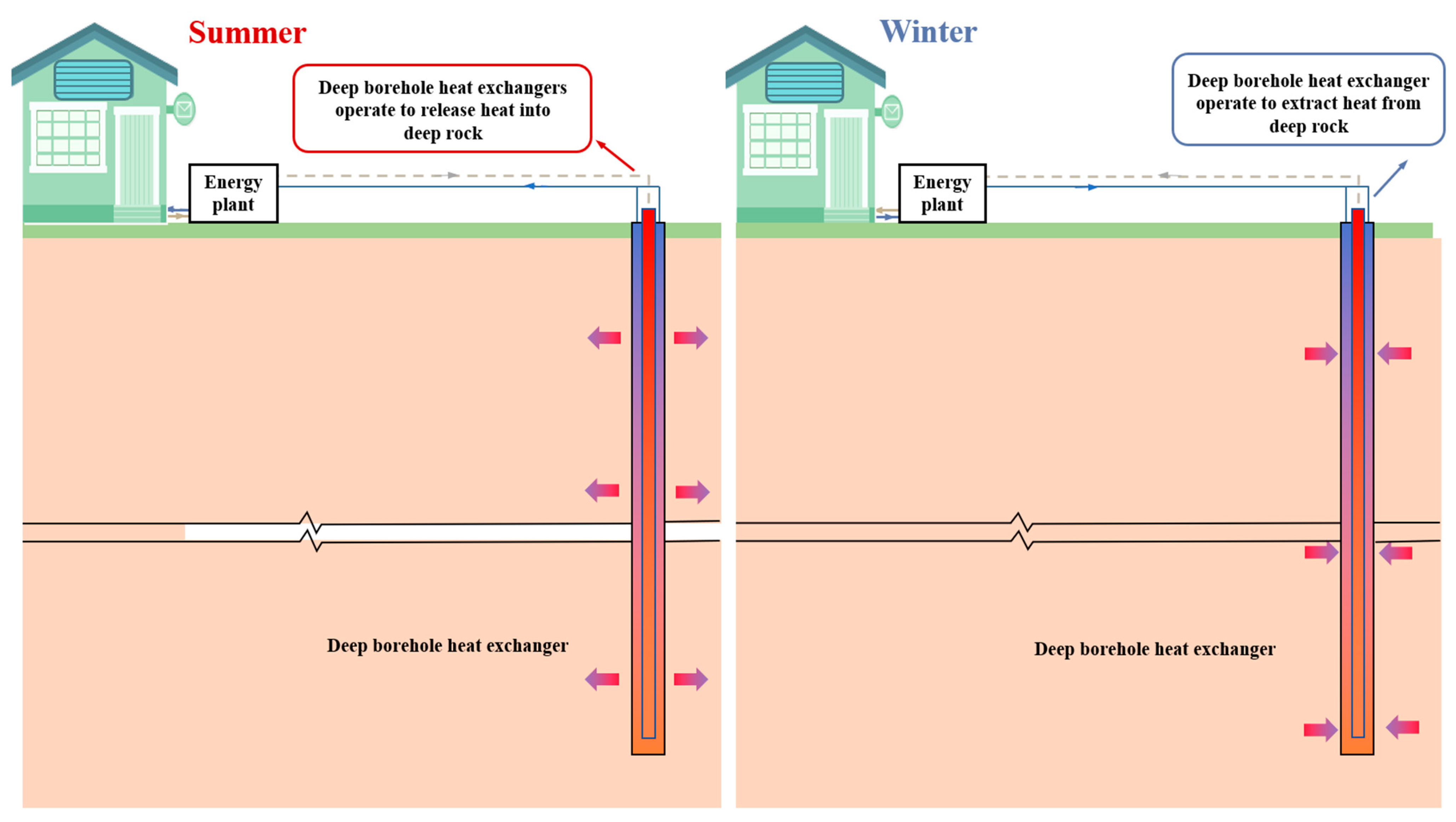
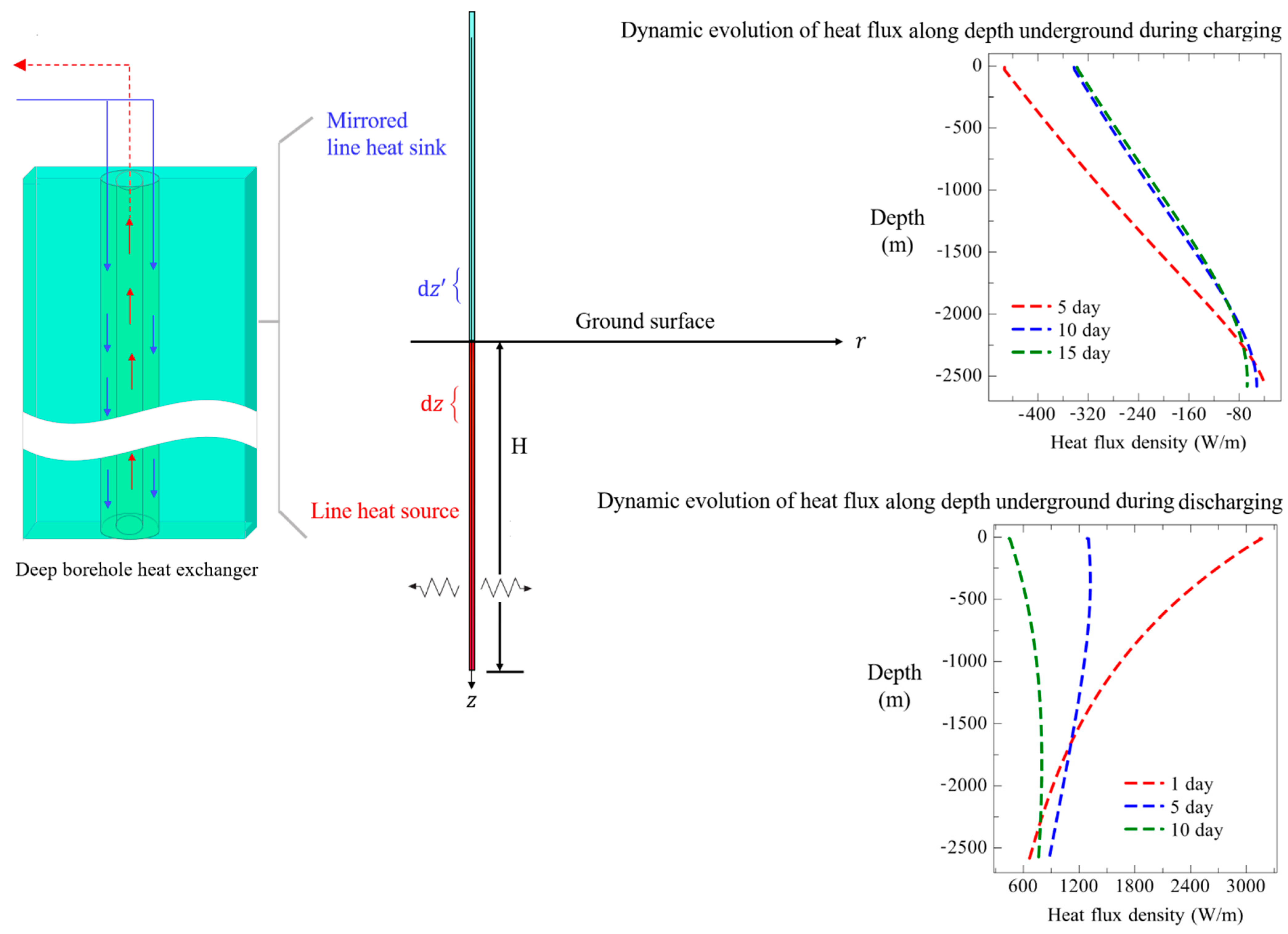

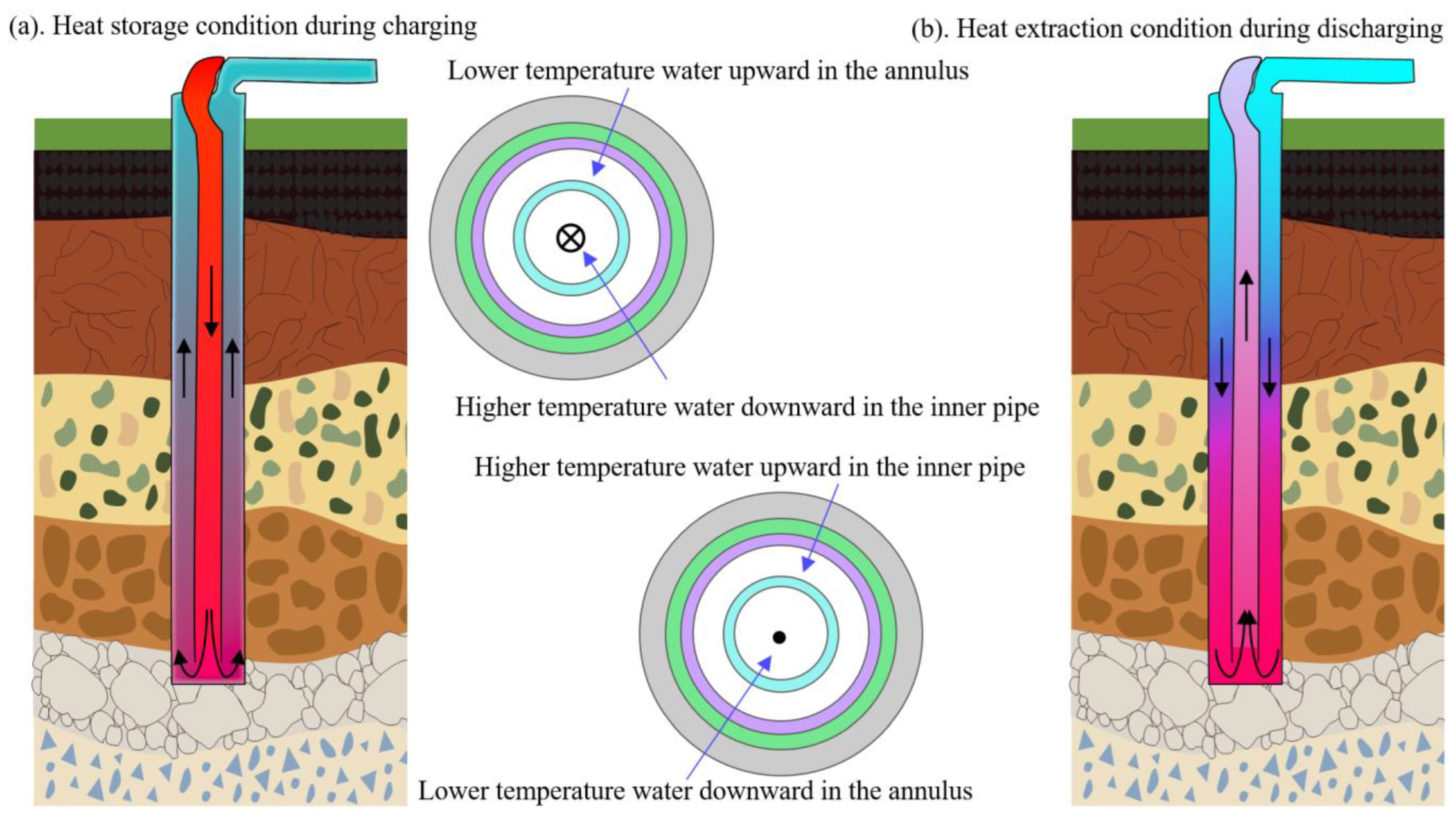

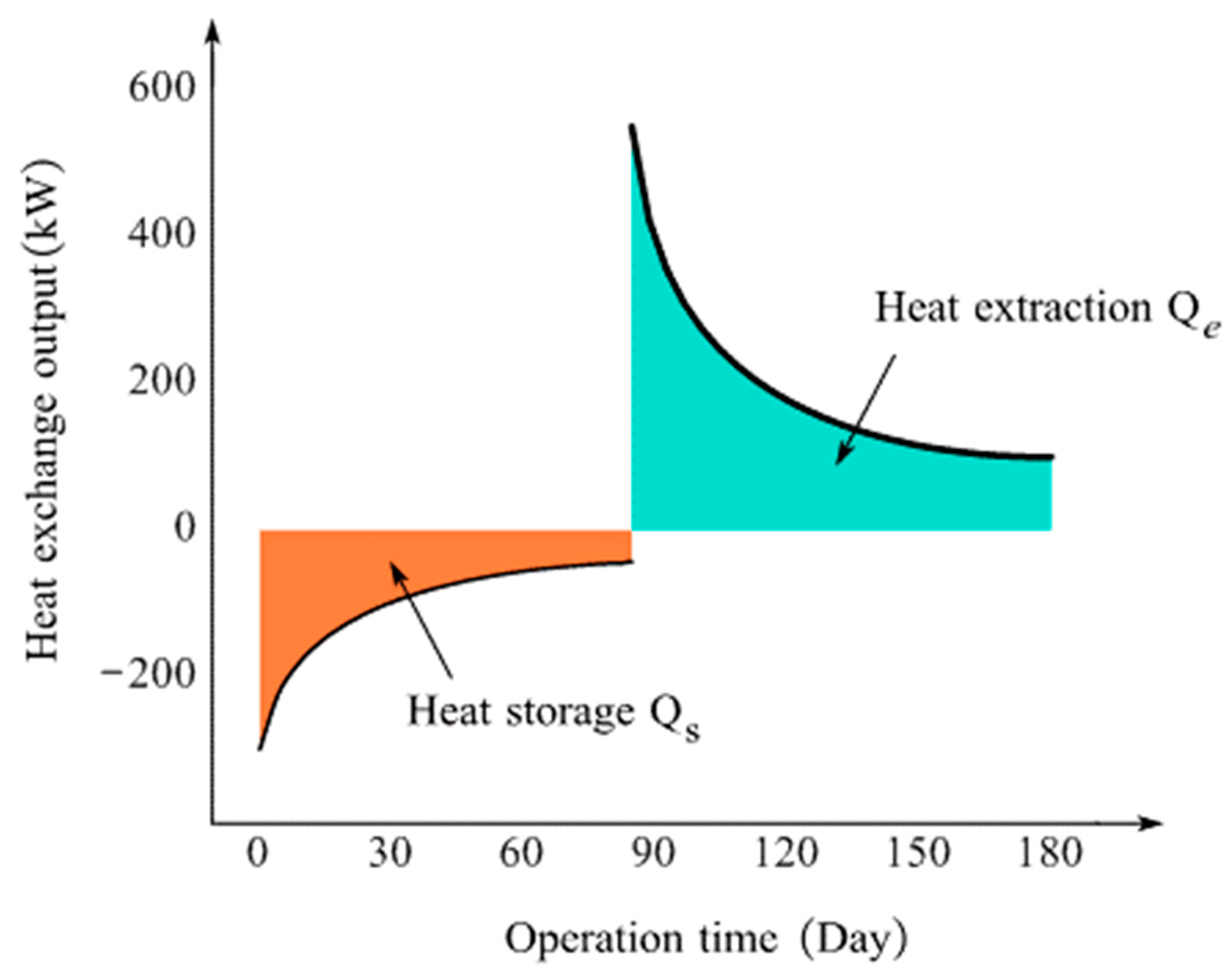
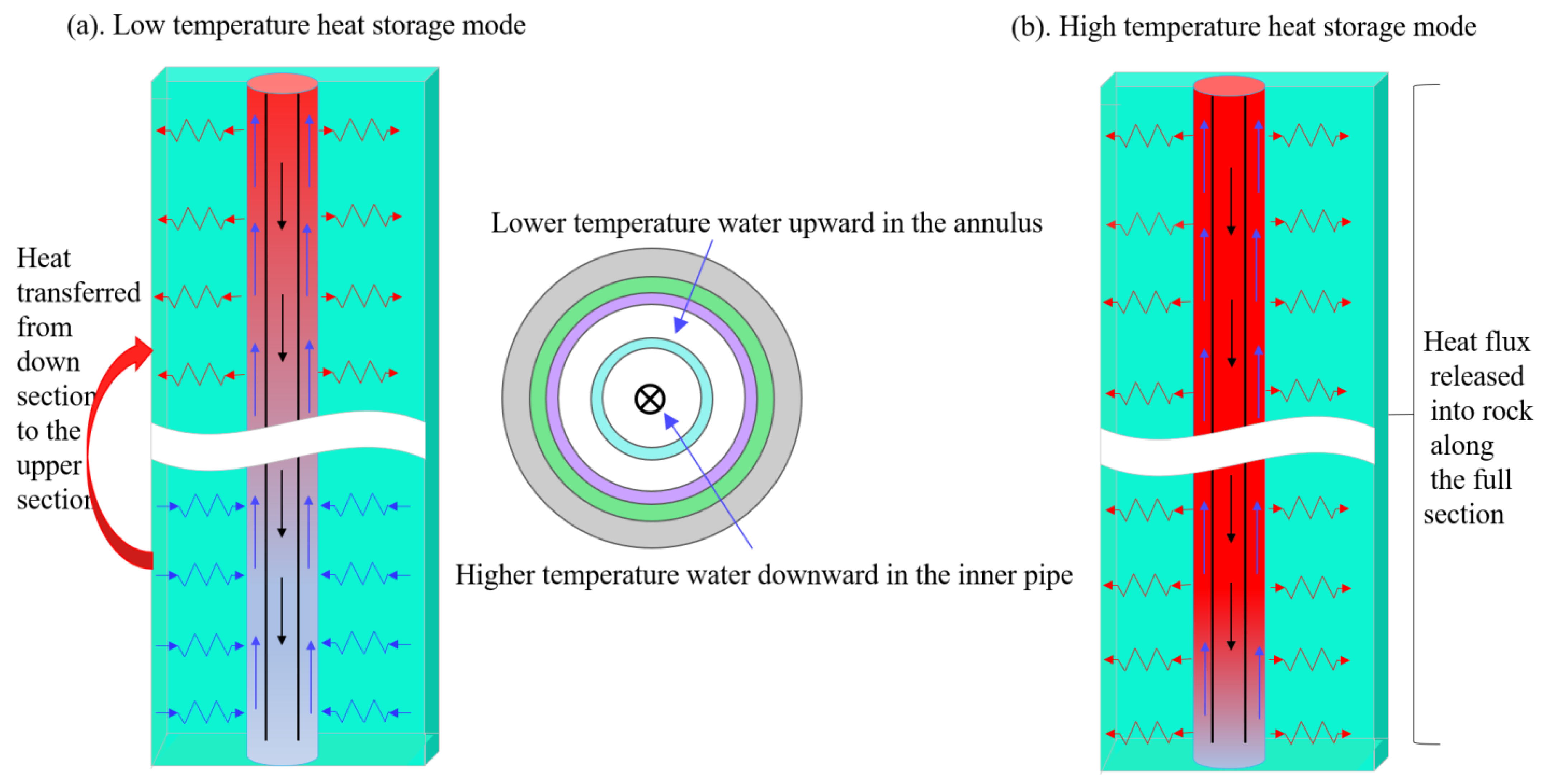

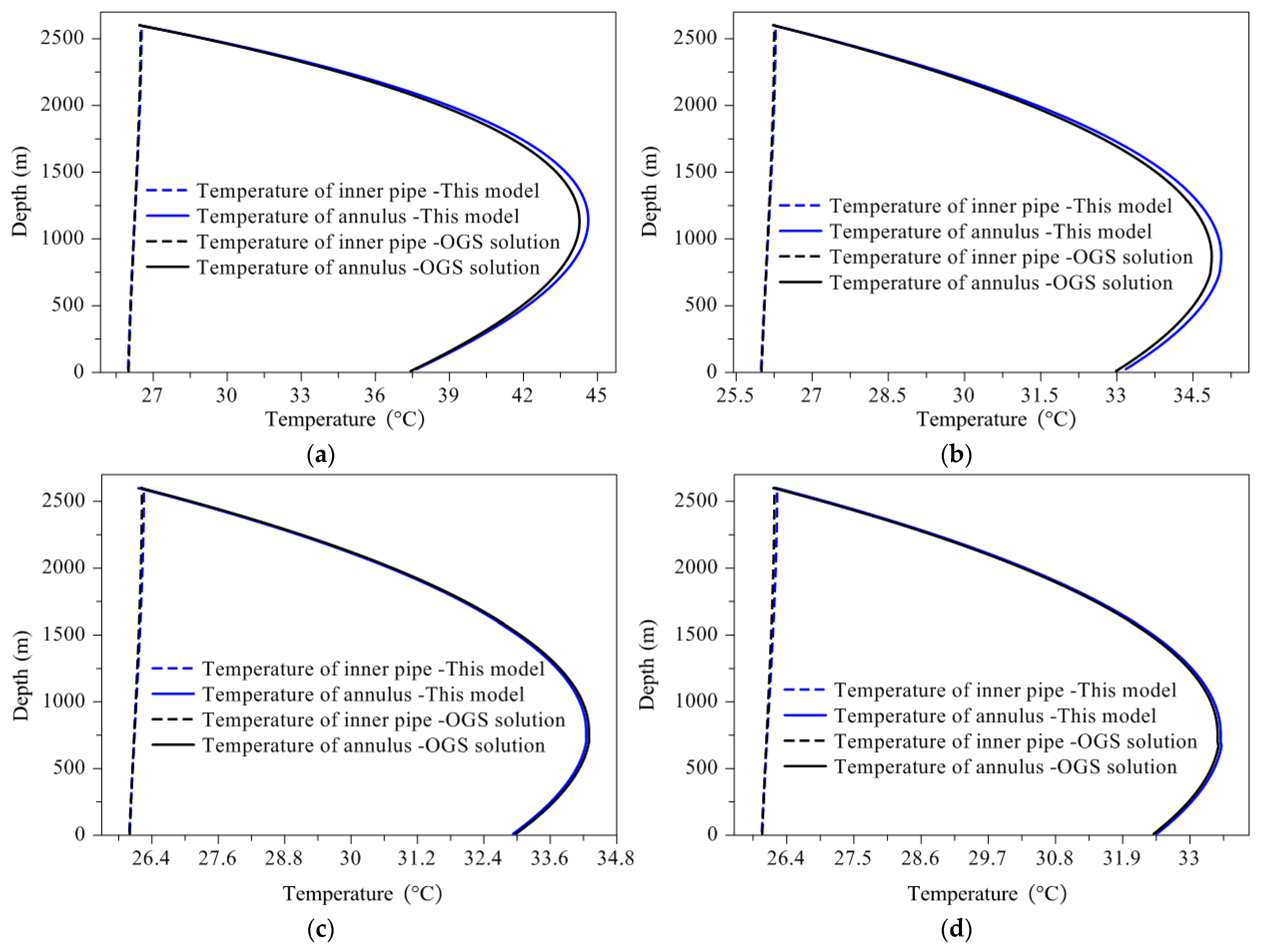



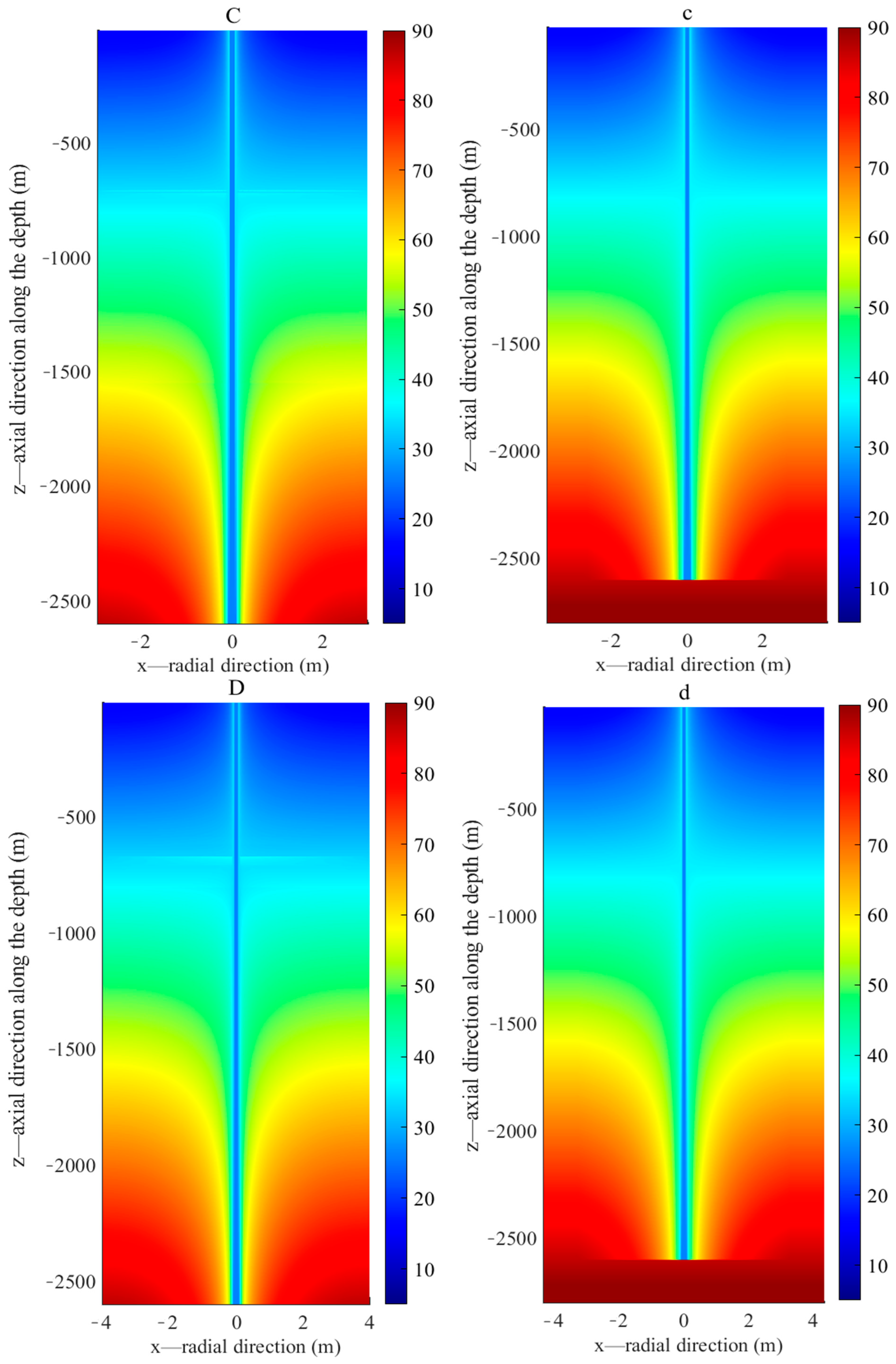

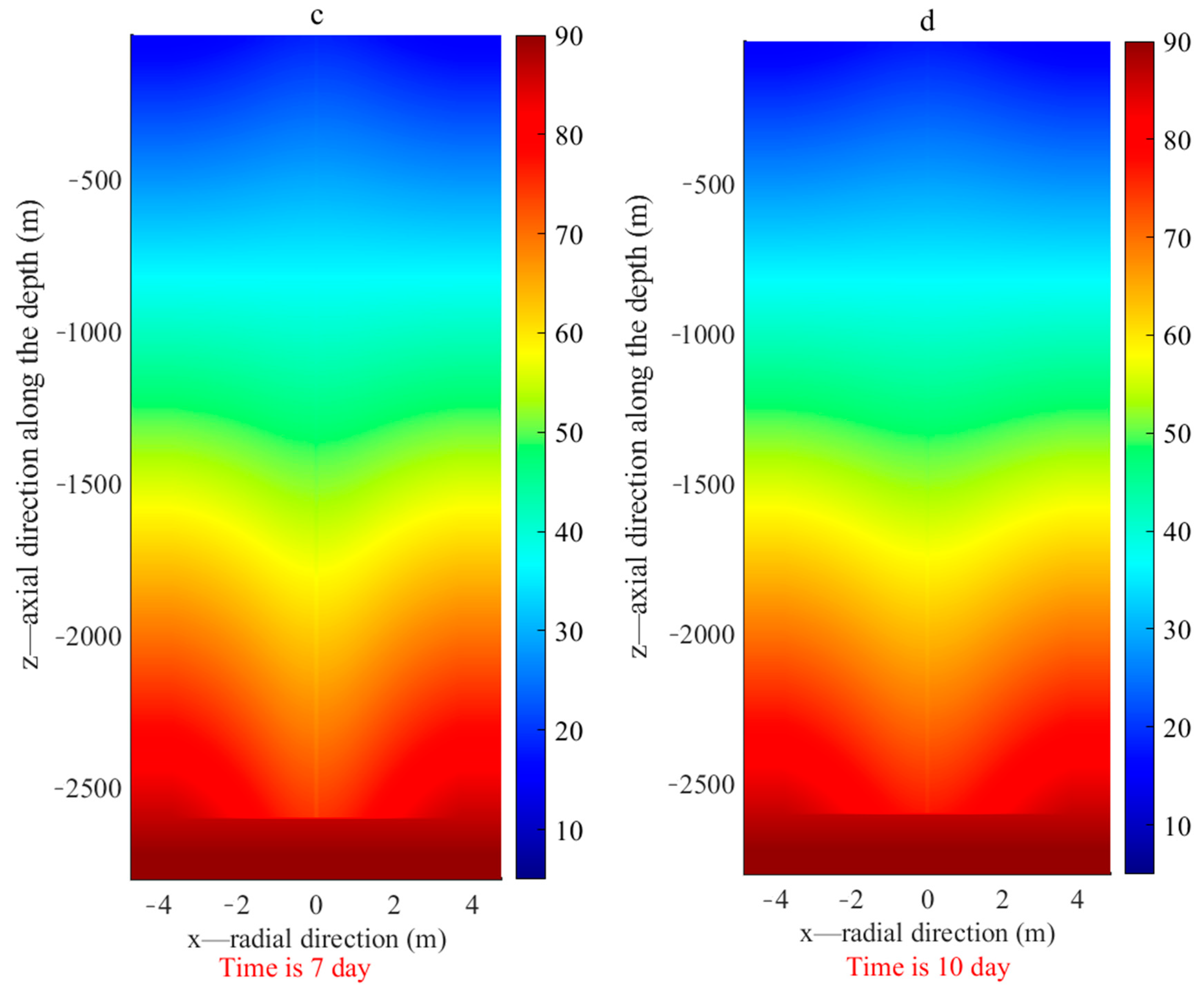
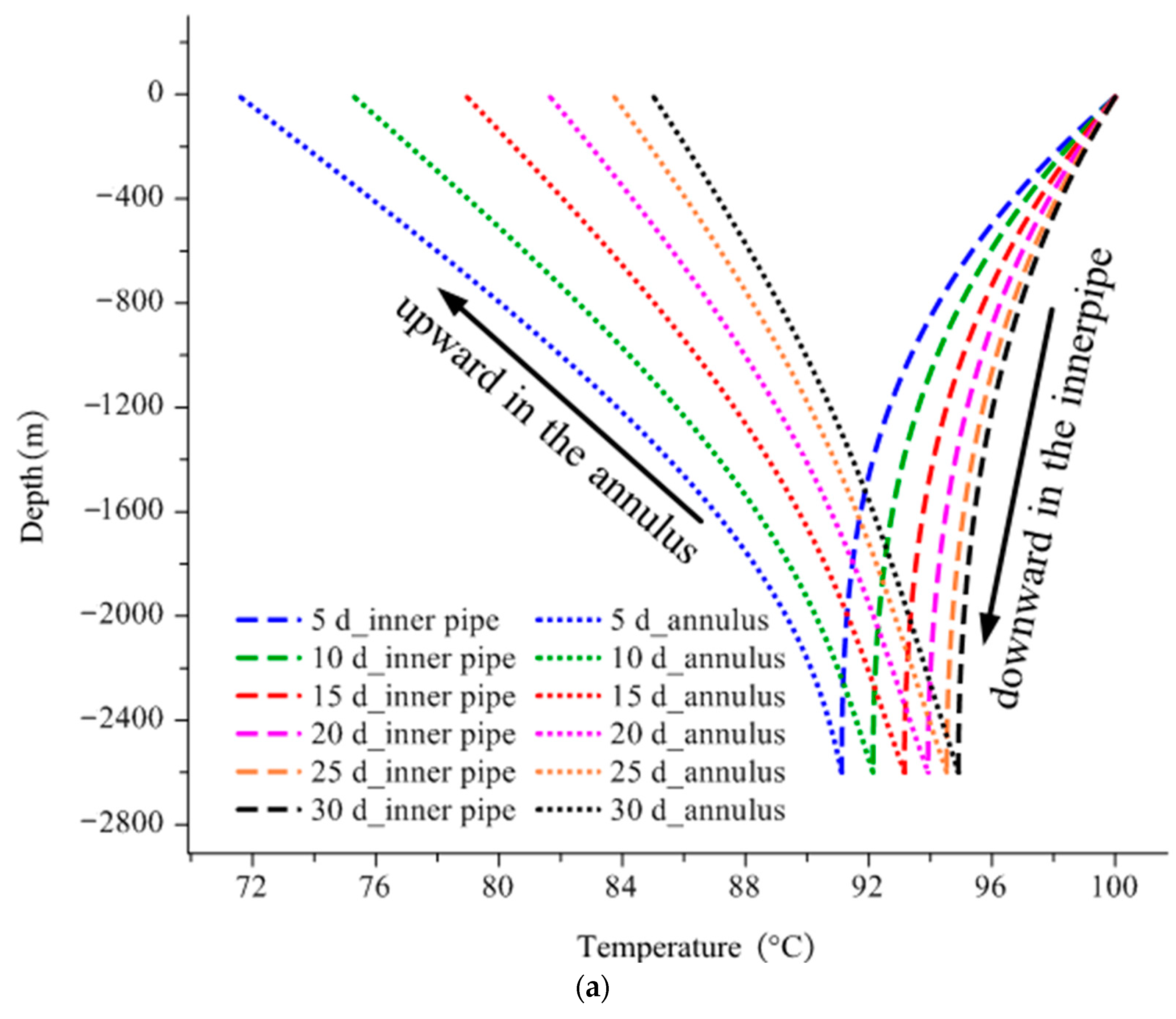
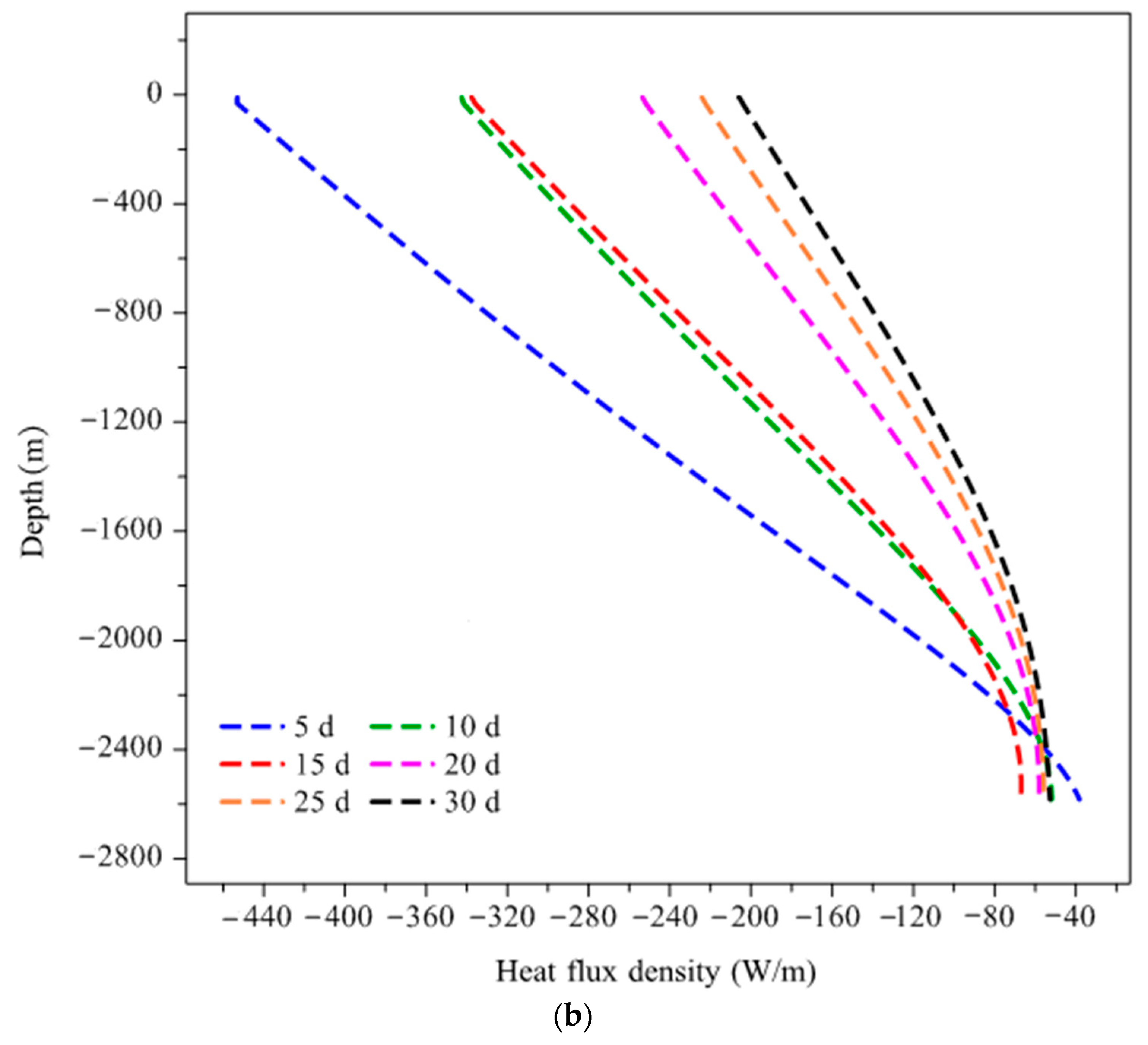
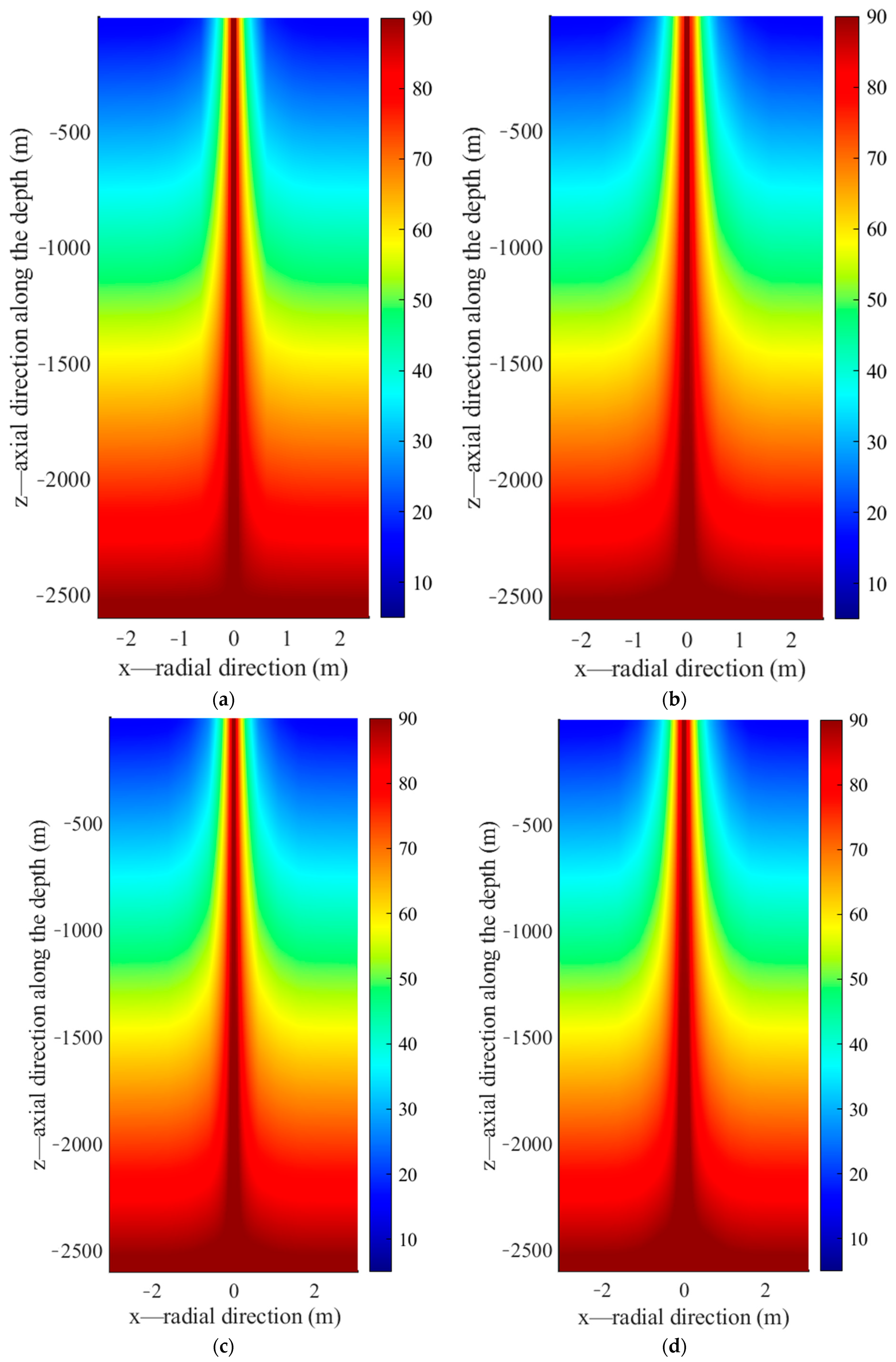


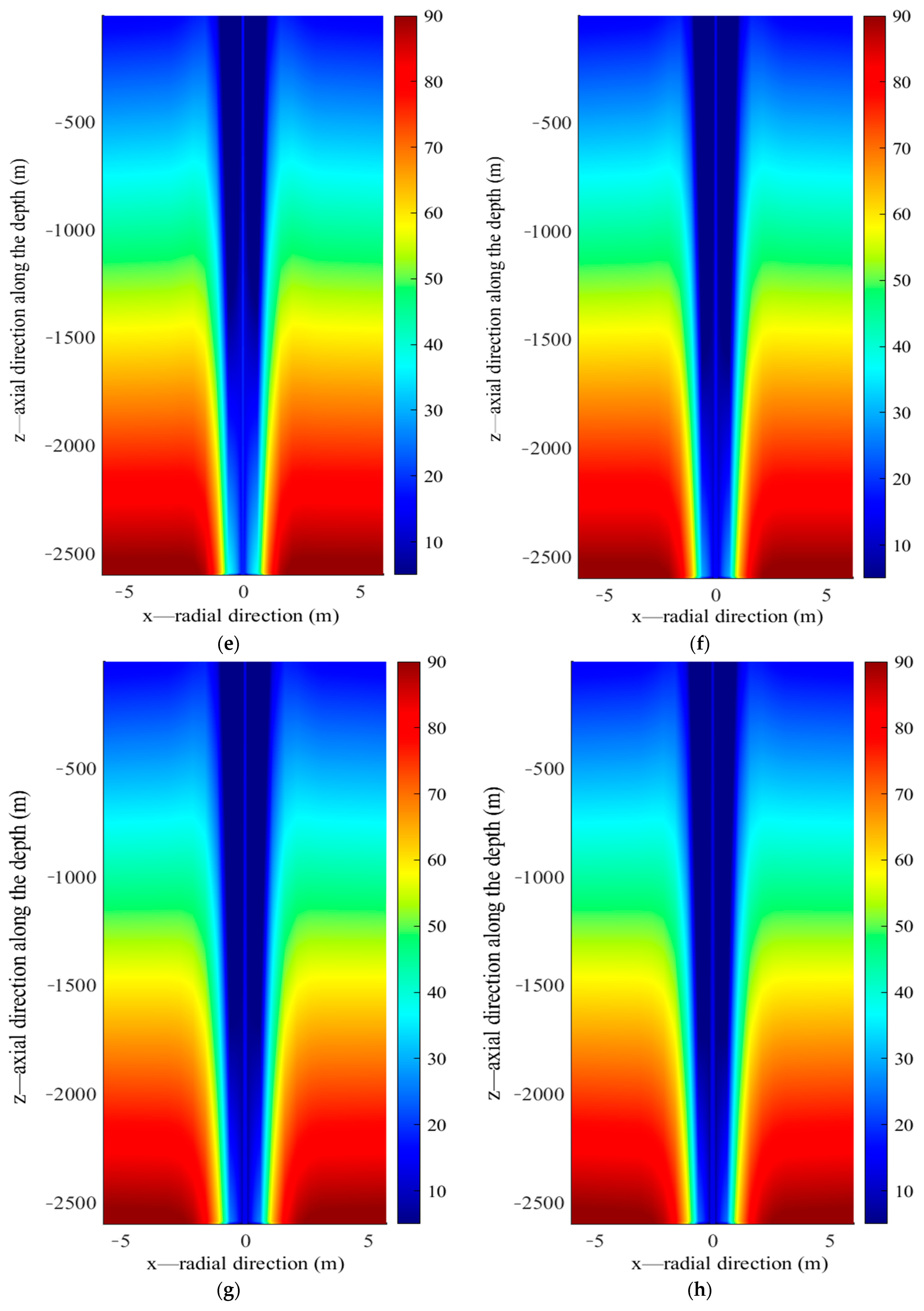
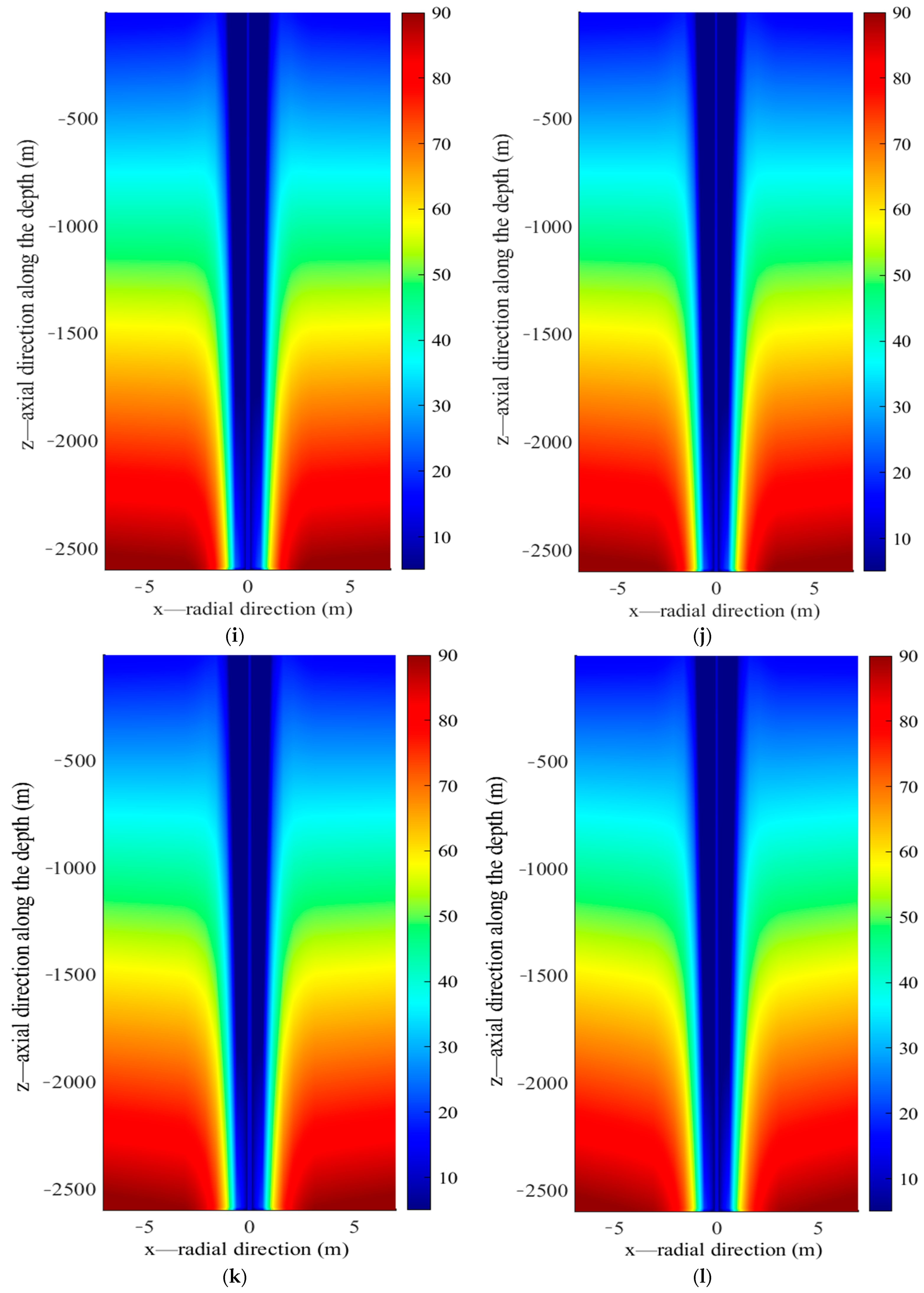

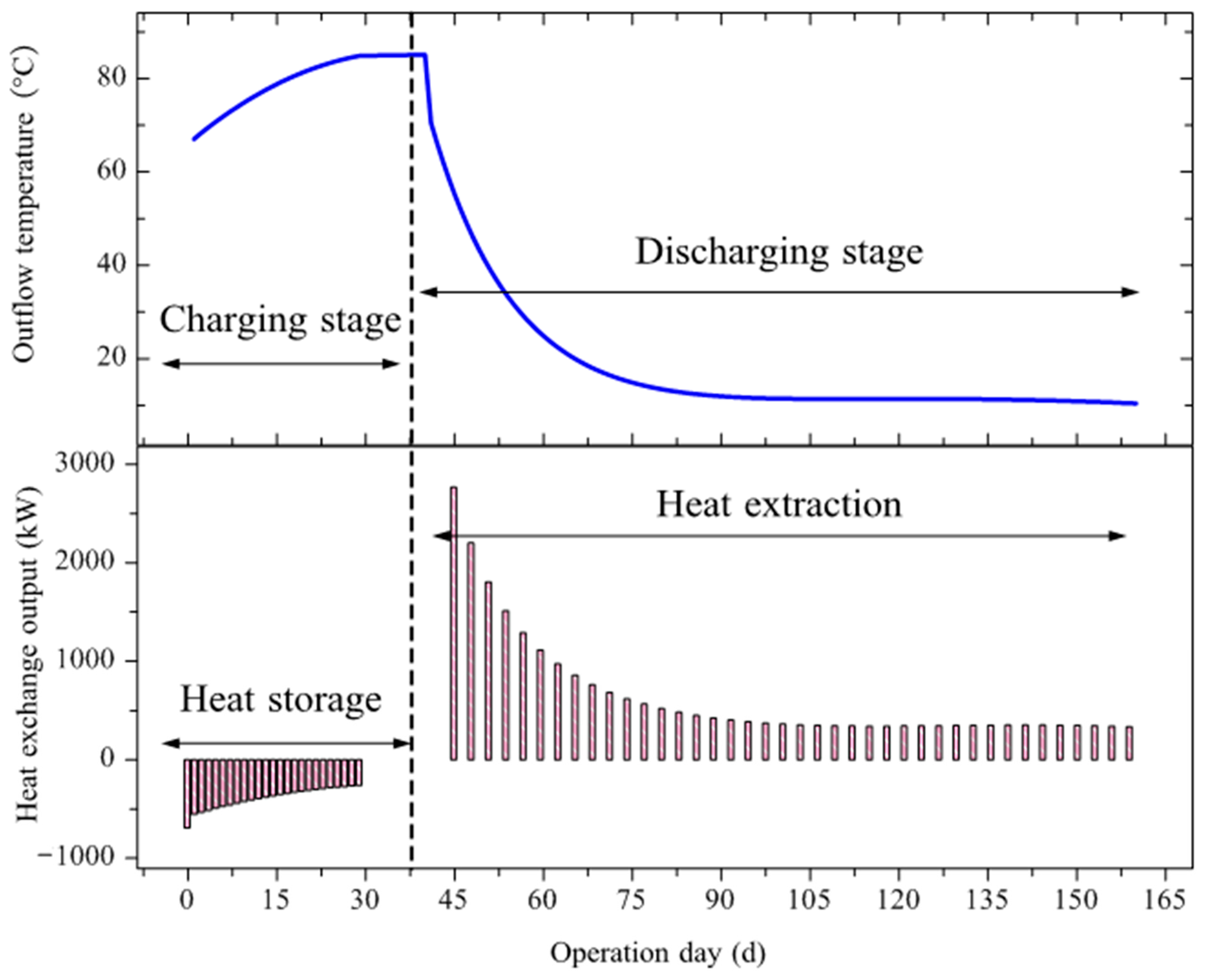

| Rock Layers | Rock Type | Depth (m) | Anisotropic Heat Conductivity | Specific Heat Capacity (J/kg/K) | Density (kg/m3) |
|---|---|---|---|---|---|
| Layer 1 | Soil | 0~100 | 1.16/1.16/1.16 | 840 | 1500 |
| Layer 2 | Basalt | 100~1985 | 2.4/2.4/2.78 | 925 | 2800 |
| Layer 3 | Sandstone | 1985~2410 | 2.6/2.6/2.8 | 920 | 2800 |
| Layer 4 | Limestone | 2410~2470 | 2.5/2.5/2.75 | 900 | 2780 |
| Layer 5 | Sandstone | 2470~2600 | 2.6/2.6/2.8 | 920 | 2800 |
| Design Parameters | Value |
|---|---|
| Drilling depth of DBHE (m) | 2600 |
| Inner pipe diameter of DBHE (mm) | 90/110 |
| Annulus diameter of DBHE (mm) | 159/178 |
| Borehole diameter of DBHE (mm) | 216 |
| Operational Parameters | Value |
|---|---|
| Charging time (days) | 30 |
| Flow rate during charging (m3/h) | 20 |
| Charging temperature (°C) | 26 |
| Operation hours per day (h) | 20 |
| Intermittence interval after charging (day) | 10 |
| Operational Parameters | Value |
|---|---|
| Discharging time (days) | 120 |
| Inlet temperature (°C) | 5 |
| Flow rate during discharging (m3/h) | 50 |
| Operation hours per day (h) | 24 |
Publisher’s Note: MDPI stays neutral with regard to jurisdictional claims in published maps and institutional affiliations. |
© 2022 by the authors. Licensee MDPI, Basel, Switzerland. This article is an open access article distributed under the terms and conditions of the Creative Commons Attribution (CC BY) license (https://creativecommons.org/licenses/by/4.0/).
Share and Cite
Qin, X.; Zhao, Y.; Dai, C.; Wei, J.; Xue, D. Thermal Performance Analysis on the Seasonal Heat Storage by Deep Borehole Heat Exchanger with the Extended Finite Line Source Model. Energies 2022, 15, 8366. https://doi.org/10.3390/en15228366
Qin X, Zhao Y, Dai C, Wei J, Xue D. Thermal Performance Analysis on the Seasonal Heat Storage by Deep Borehole Heat Exchanger with the Extended Finite Line Source Model. Energies. 2022; 15(22):8366. https://doi.org/10.3390/en15228366
Chicago/Turabian StyleQin, Xiangxi, Yazhou Zhao, Chengjun Dai, Jian Wei, and Dahai Xue. 2022. "Thermal Performance Analysis on the Seasonal Heat Storage by Deep Borehole Heat Exchanger with the Extended Finite Line Source Model" Energies 15, no. 22: 8366. https://doi.org/10.3390/en15228366









